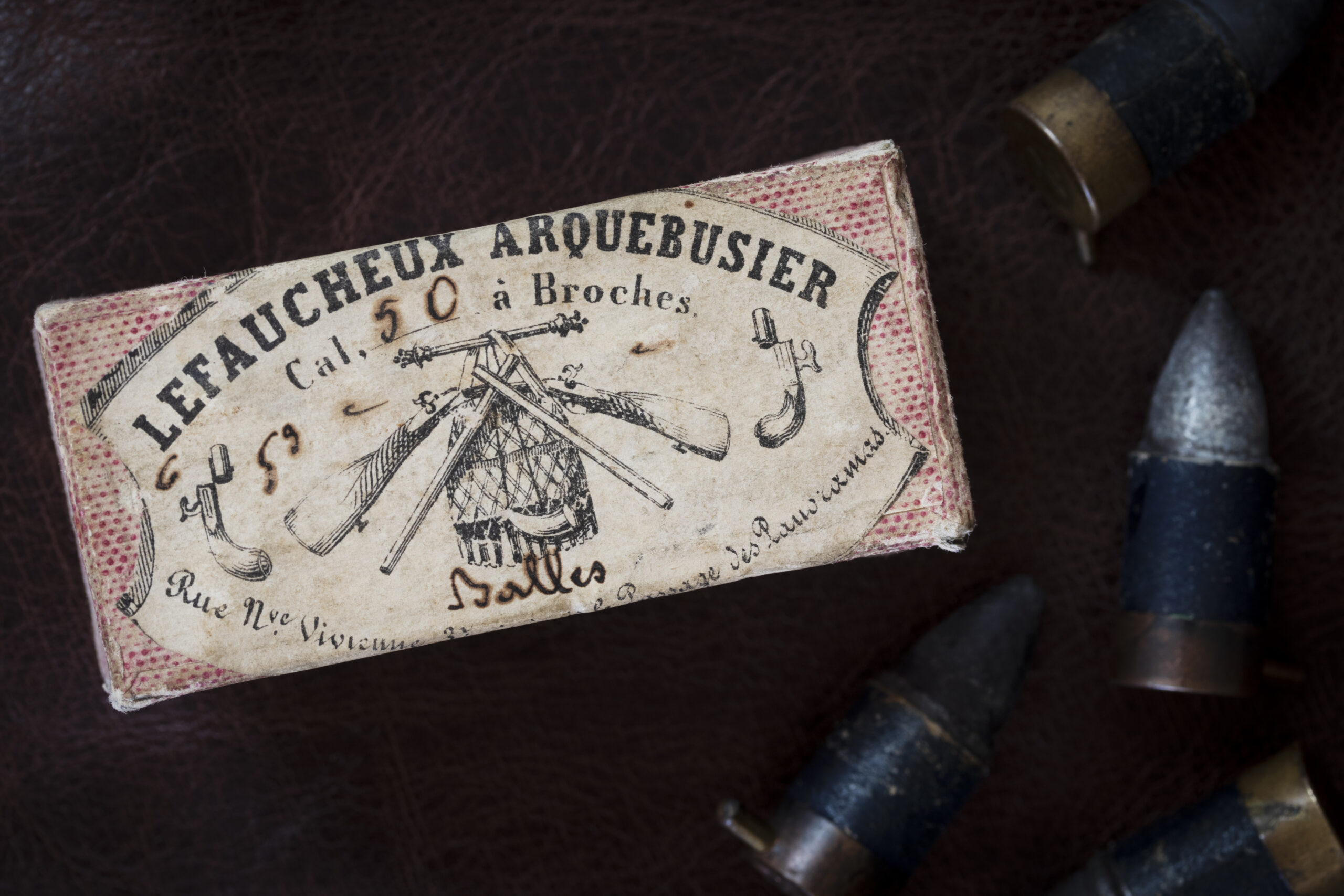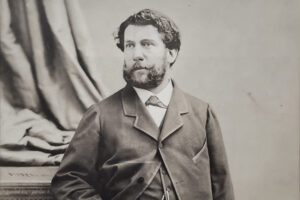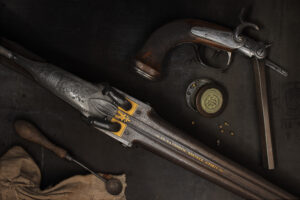In the rich tapestry of firearms history, few inventions have had as profound an impact as the pinfire system. Born from the ingenious mind of French gunsmith Casimir Lefaucheux, this groundbreaking innovation marked a pivotal turning point in the evolution of firearms technology. Patented in France in 1835, the pinfire system revolutionized the way guns were designed, loaded, and fired, ushering in a new era of safety, reliability, and efficiency.
Before Lefaucheux’s invention, the world of firearms was dominated by muzzle-loading weapons. These guns required the shooter to manually load gunpowder, wadding, and projectile into the barrel from the muzzle end, a time-consuming and often perilous process. Misfires were a constant threat, especially in damp or humid conditions, and the risk of double-charging the gun – loading twice the intended amount of gunpowder – loomed large. The pinfire system, with its self-contained cartridges, elegantly addressed these challenges, offering a safer and more dependable alternative.
At the heart of the pinfire system was the ingenious design of the cartridge itself. A small pin protruded from the side of each cartridge, giving the system its distinctive name. When the gun’s hammer struck this pin, it ignited the primer within the cartridge, which in turn ignited the main powder charge, propelling the bullet out of the barrel. This innovative mechanism not only streamlined the loading process but also greatly reduced the risk of accidental discharges and misfires.
The benefits of the pinfire system extended far beyond mere convenience. By integrating the bullet, gunpowder, and ignition mechanism into a single, self-contained unit, Lefaucheux’s invention revolutionized the very concept of ammunition. No longer would shooters have to contend with the clumsy and potentially hazardous process of measuring out loose powder and projectiles. The pinfire cartridge offered a level of consistency, reliability, and ease of use that was unheard of in its time.
Lefaucheux’s impact on the world of firearms cannot be overstated. His vision and ingenuity reflected the spirit of innovation that characterized the early 19th century, a time of rapid industrial and technological advancement. From the workshops of pioneers like Jean Samuel Pauly, where Lefaucheux honed his craft, to the battlefields and hunting grounds where his inventions proved their worth, the pinfire system left an indelible mark on the history of firearms.
As we delve into the story of Casimir Lefaucheux and his revolutionary invention, we are not merely exploring a single chapter in the annals of firearms development. Rather, we are tracing the steps of a visionary who, through his tireless pursuit of innovation, set the stage for a new era in gun design and functionality. The pinfire system laid the foundation for the breech-loading firearms that would come to dominate the modern era, and its influence can still be felt in the guns we use today.
In the following sections, we will explore the fascinating history of the pinfire system, from its earliest beginnings to its global impact and enduring legacy. We will examine the technical intricacies of Lefaucheux’s design, the challenges he faced, and the collaborations that helped bring his vision to life. Through this journey, we will come to appreciate the true scope of Casimir Lefaucheux’s genius and the transformative power of his invention.
So, let us step into the world of the pinfire system and discover the story of a remarkable man whose ingenuity and determination forever changed the face of firearms technology. In the hands of Casimir Lefaucheux, the gun became not just a tool, but a testament to the boundless potential of human innovation. His legacy endures to this day, inspiring new generations of gunsmiths, collectors, and enthusiasts who continue to push the boundaries of what is possible in the realm of firearms.
The Birth of the Pinfire System: From Flintlocks to Lefaucheux’s Revolution
The story of the pinfire system, a pivotal development in firearms technology, is a tale of ingenuity, perseverance, and the relentless pursuit of innovation. Its roots can be traced back to the early 19th century, a time of great change and progress in the world of firearms. This was an era marked by a transition from the antiquated flintlock mechanisms, prone to misfires and reliability issues, to the more advanced percussion cap systems. It was against this backdrop of technological ferment that Casimir Lefaucheux, a French gunsmith with a vision for the future, would rise to prominence and forever change the course of firearms history.
The Foundations: Building on the Work of Pioneers
Before Lefaucheux’s groundbreaking invention, the world of firearms had already begun to evolve, thanks in large part to the work of innovative gunsmiths like Jean Samuel Pauly. A Swiss inventor with a keen eye for the limitations of traditional muzzle-loading firearms, Pauly had developed one of the first practical breech-loading designs, as well as a self-contained cartridge system. These advancements laid the foundation for the pinfire system and other breech-loading innovations that would follow.
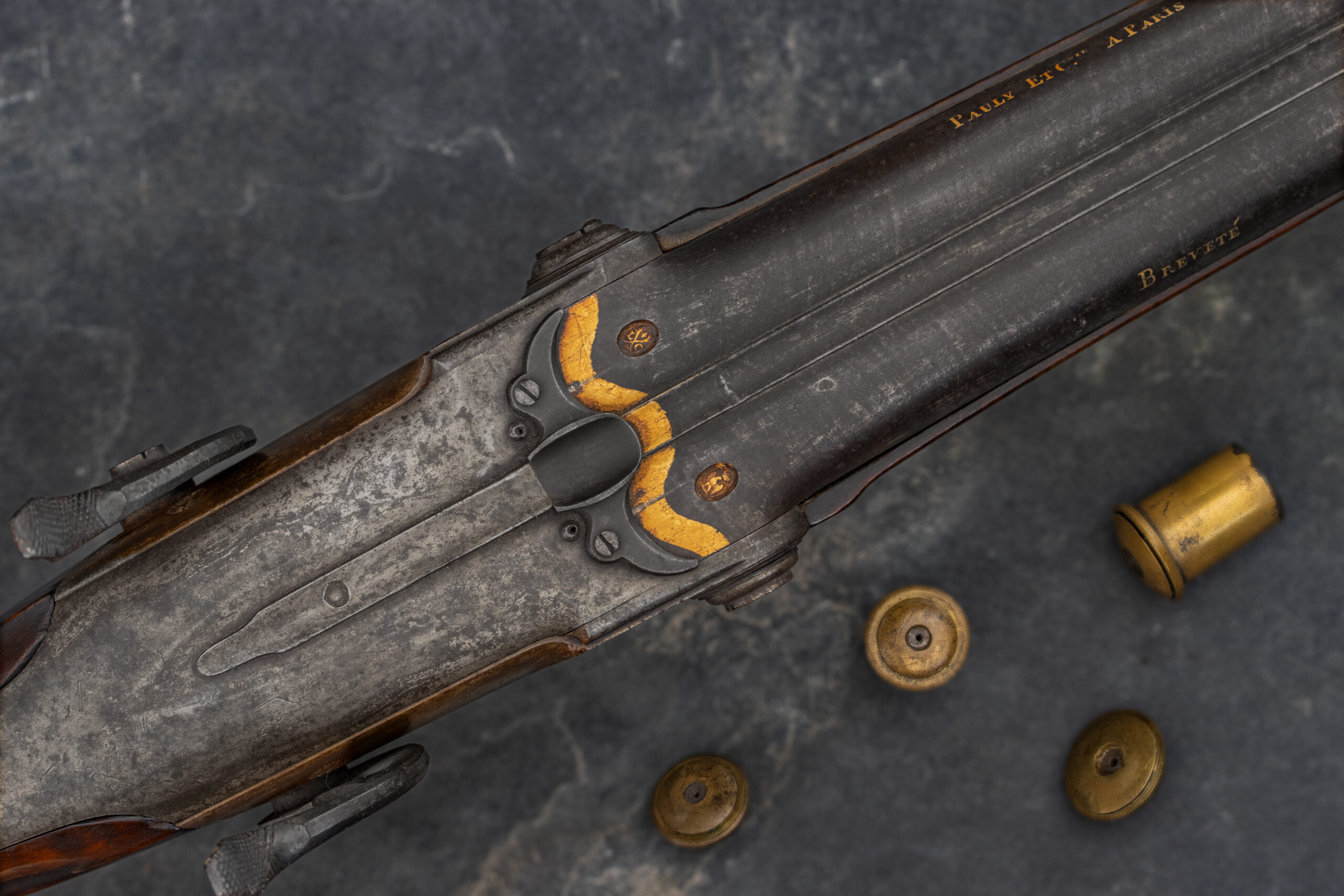
As a young apprentice, Lefaucheux was immersed in this world of rapid technological change. He studied the work of pioneers like Pauly and became increasingly convinced that the future of firearms lay in the development of more reliable, efficient, and user-friendly designs. Despite the improvements offered by percussion cap systems, Lefaucheux recognized that these still had their drawbacks, particularly the need to manually place a cap before each shot. He set out to find a better solution, one that would combine the benefits of breech-loading with a more integrated and streamlined ignition mechanism.
The Road to the Pinfire: Lefaucheux’s Early Experiments
Lefaucheux’s journey towards the invention of the pinfire system began in earnest in 1827, when he acquired the Pauly company and its valuable patents. This strategic move positioned him at the forefront of the firearms industry and gave him the resources and expertise needed to pursue his own innovative designs. Over the next several years, Lefaucheux devoted himself to the study of breech-loading mechanisms and ignition systems, constantly experimenting and refining his ideas.
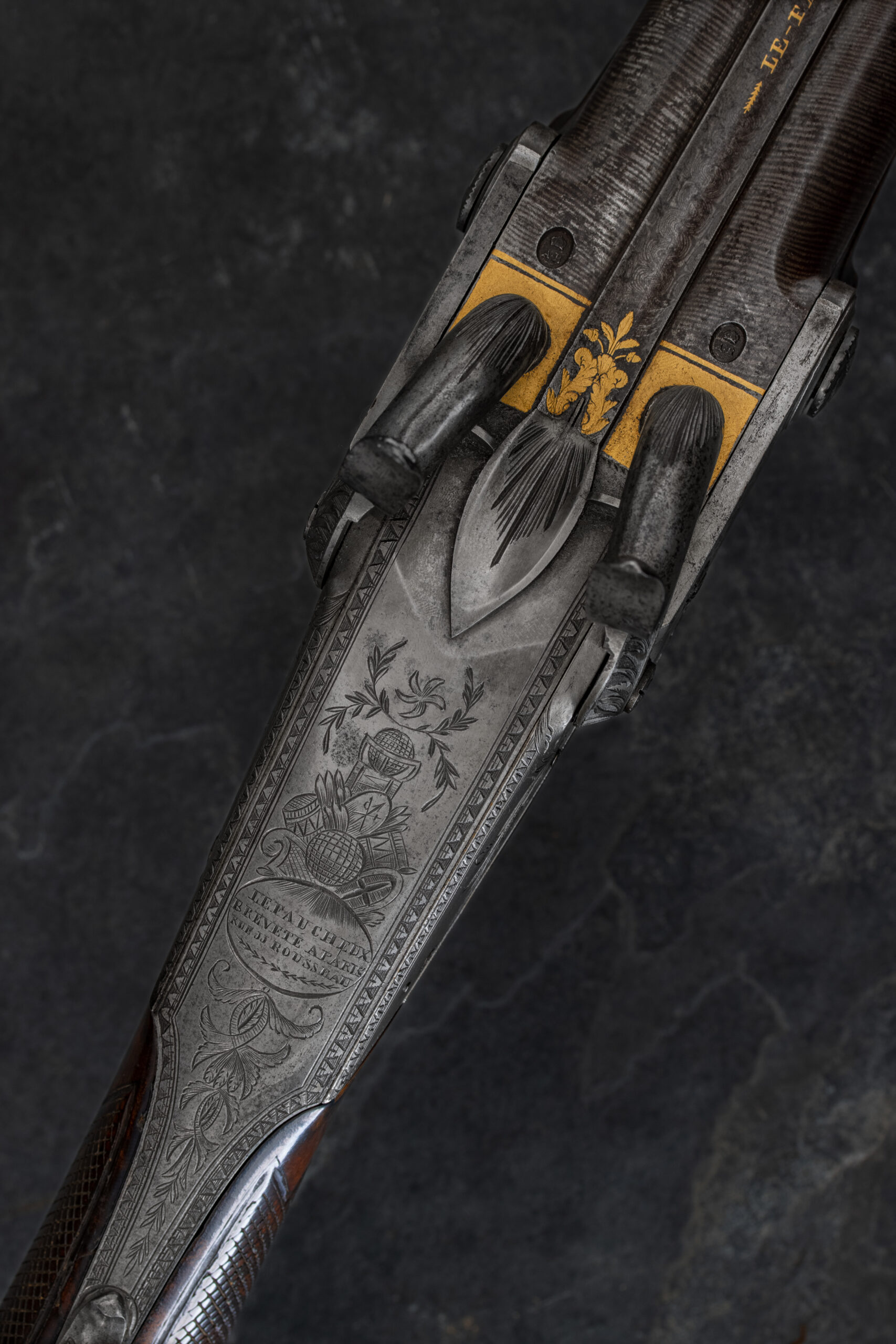
As he worked, Lefaucheux drew inspiration from the advancements being made by his contemporaries. The annular-primed cartridge developed by Béatus Béringer, for example, featured a flexible metallic base that offered a tantalizing glimpse of the potential for more reliable and efficient ammunition. However, Béringer’s design was just one of many innovations that caught Lefaucheux’s attention during this period, as he studied the work of rivals and collaborators alike in his quest to create the perfect breech-loading system.
A Convergence of Innovations: The Competitive Landscape of the 1830s
The 1830s were a time of intense competition and innovation in the world of firearms, as gunsmiths across Europe raced to develop the next great breakthrough. Lefaucheux found himself at the center of this ferment, engaging in a high-stakes rivalry with the likes of Béringer and Joseph-Alexandre Robert. The legal battles and subsequent settlement between Lefaucheux and Béringer, in particular, only served to further fuel the competitive fires and drive Lefaucheux to new heights of inventiveness.
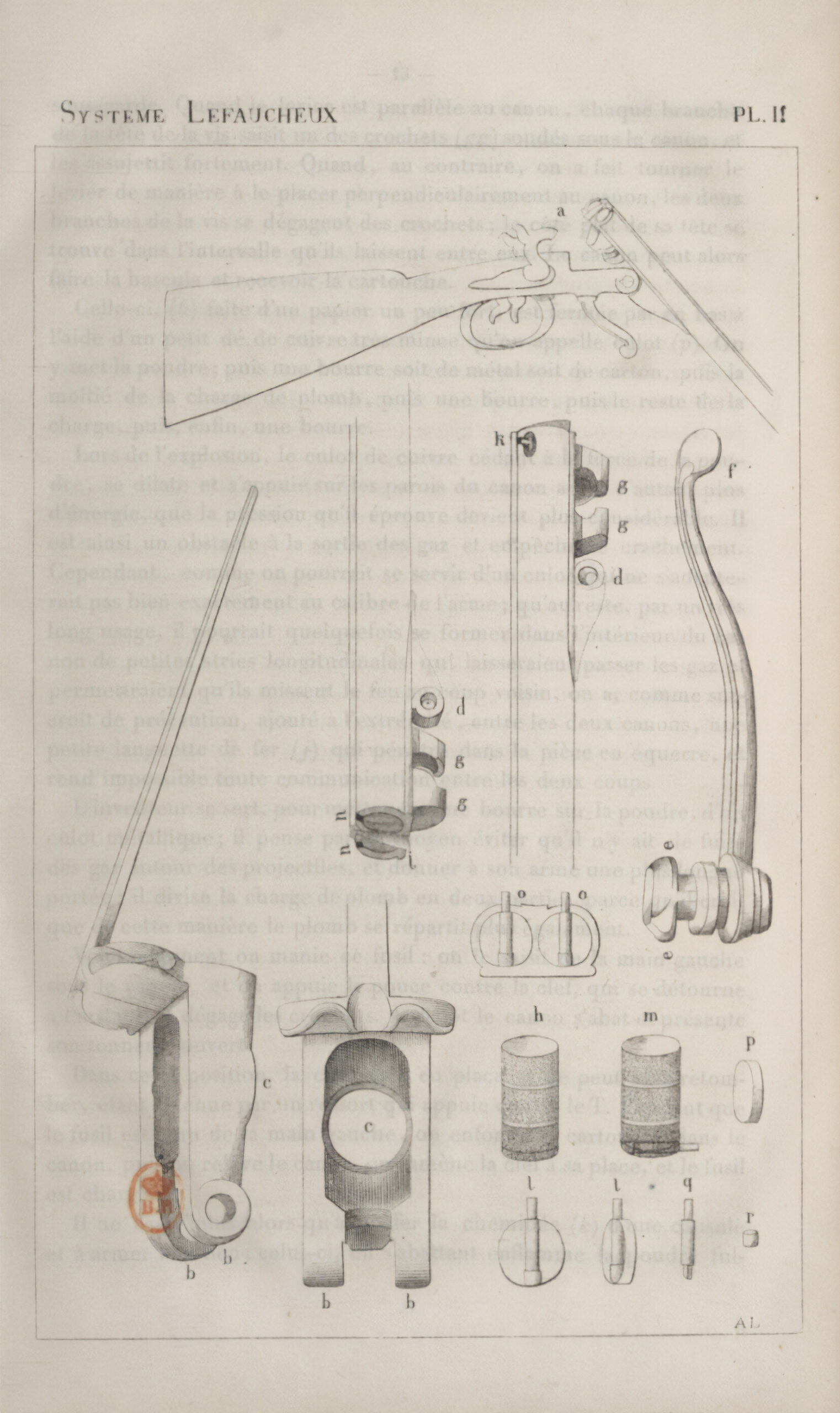
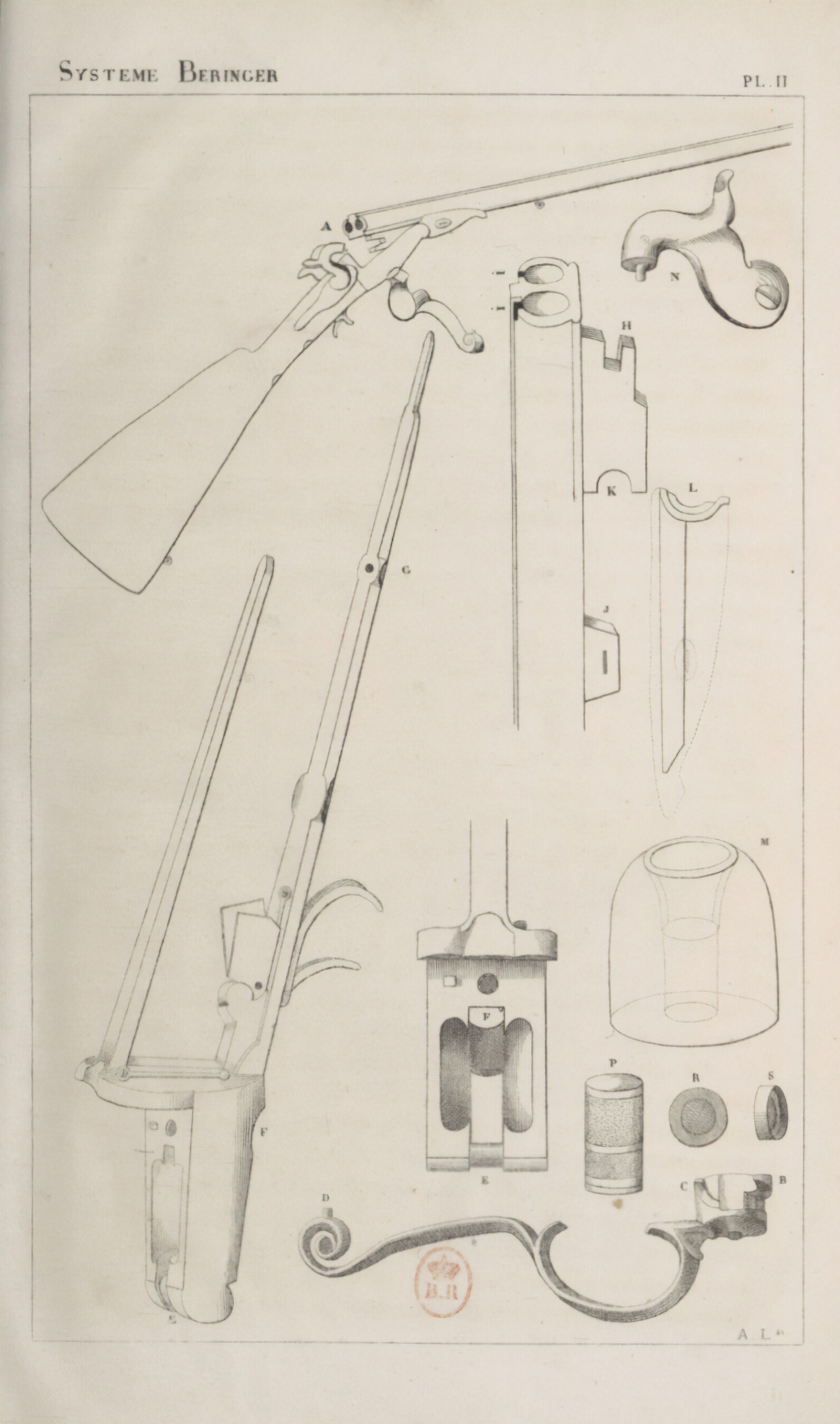
Throughout this period, Lefaucheux’s work was extensively documented in publications like the Journal Des Armes Spéciales, which chronicled the latest developments in firearms technology. The pages of these journals offer a fascinating glimpse into the world of 19th-century gunsmithing, revealing the intense pride and patriotism that drove French inventors like Lefaucheux to seek ever-greater levels of precision, reliability, and innovation in their designs.
The Birth of the Pinfire: Lefaucheux’s Crowning Achievement
It was against this backdrop of fierce competition and rapid technological change that Casimir Lefaucheux finally unveiled his masterpiece: the pinfire system. Patented in 1835, this revolutionary design featured a self-contained cartridge with a small pin protruding from its side. When struck by the gun’s hammer, this pin would ignite the internal primer, firing the bullet with unprecedented speed and reliability.
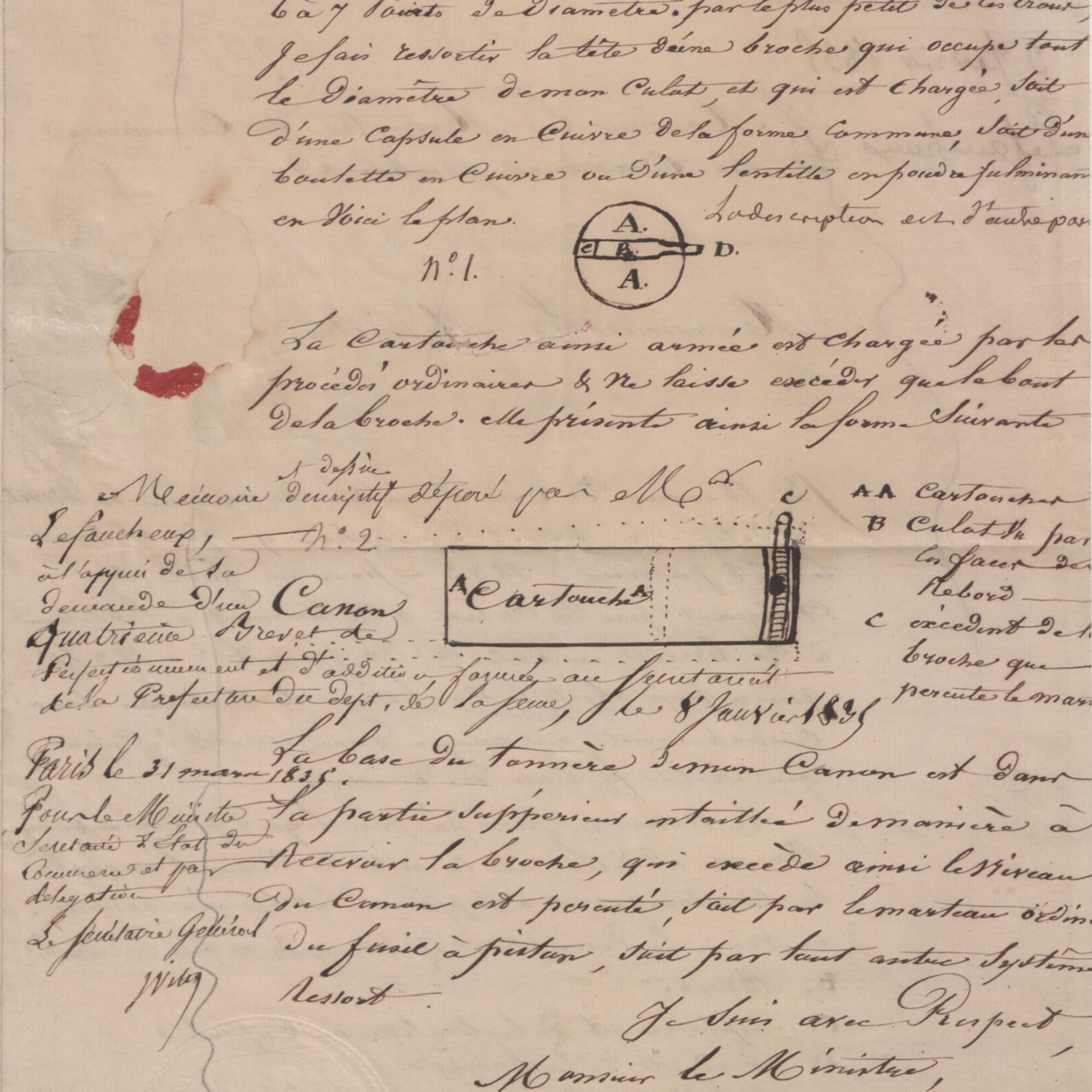
The pinfire system represented a quantum leap forward in firearms technology, offering a level of performance and ease of use that was unmatched by any other design of its time. By integrating the bullet, gunpowder, and ignition mechanism into a single, self-contained unit, Lefaucheux had created a system that was not only more reliable and efficient than its predecessors, but also far simpler and safer to use. The days of fumbling with loose powder, caps, and other components were finally over, replaced by a streamlined and user-friendly design that would set the standard for generations to come.
Design and Functionality: The Ingenious Mechanics of the Pinfire System
Casimir Lefaucheux’s patent submissions to the French government and his communications with the Ministère du commerce et des travaux publics provide valuable insights into the design and functionality of his revolutionary pinfire system. By examining the technical aspects of the pinfire cartridge, the firing mechanism, and the innovative features introduced by Lefaucheux, we can better understand how this invention transformed the firearm landscape.
The Pinfire Cartridge: A Self-Contained Unit
The essence of Lefaucheux’s pinfire design lies in its unique cartridge, which features a laterally protruding pin. This pin is integral to the cartridge’s body and serves as the ignition point for the contained primer when struck by the firearm’s hammer. The cartridge itself is a self-contained unit, comprising the bullet, gunpowder, and primer. This integration marked a significant departure from the separate components used in earlier firearms, streamlining the loading process and enhancing the overall safety and reliability of the system.
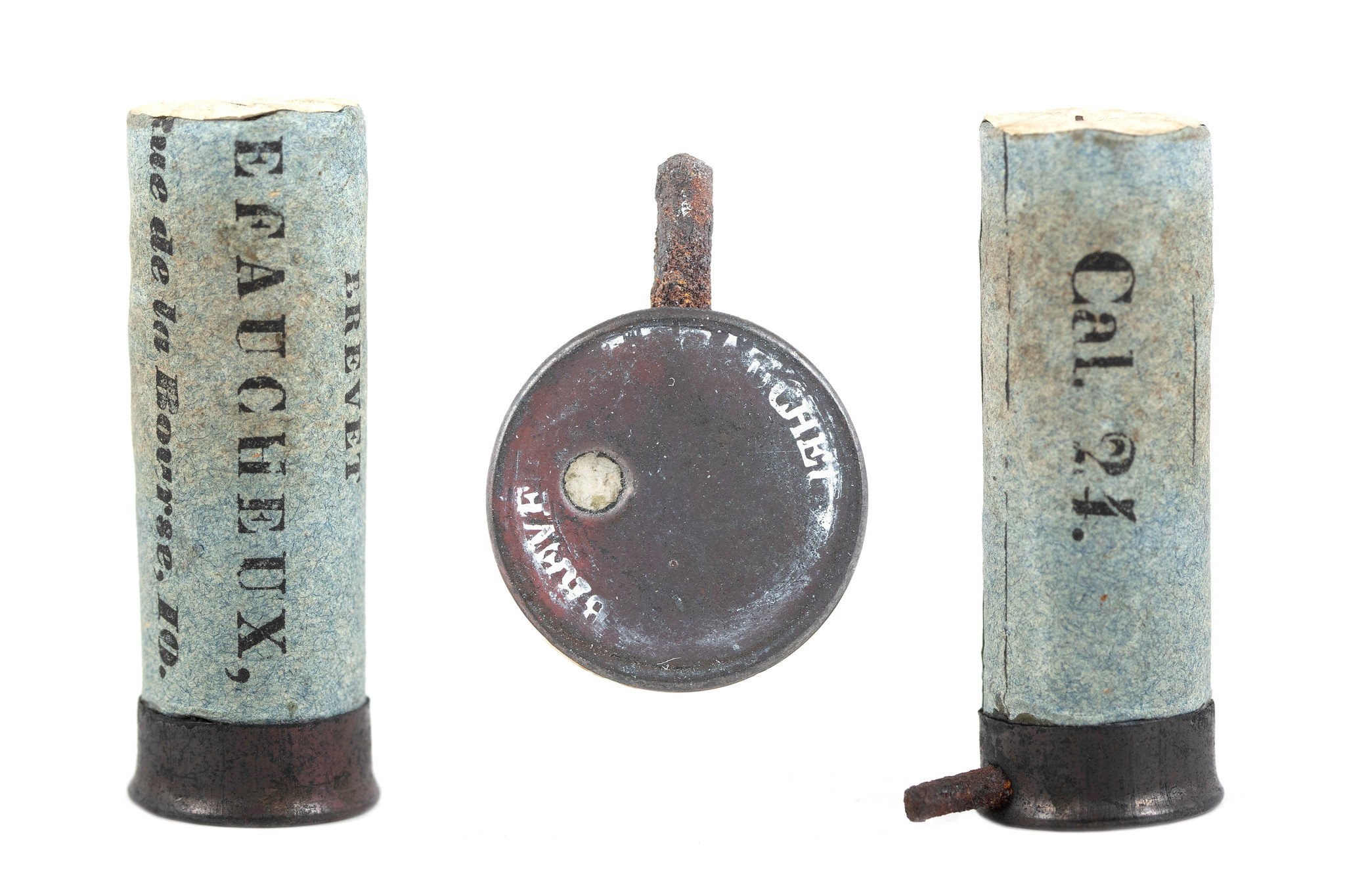
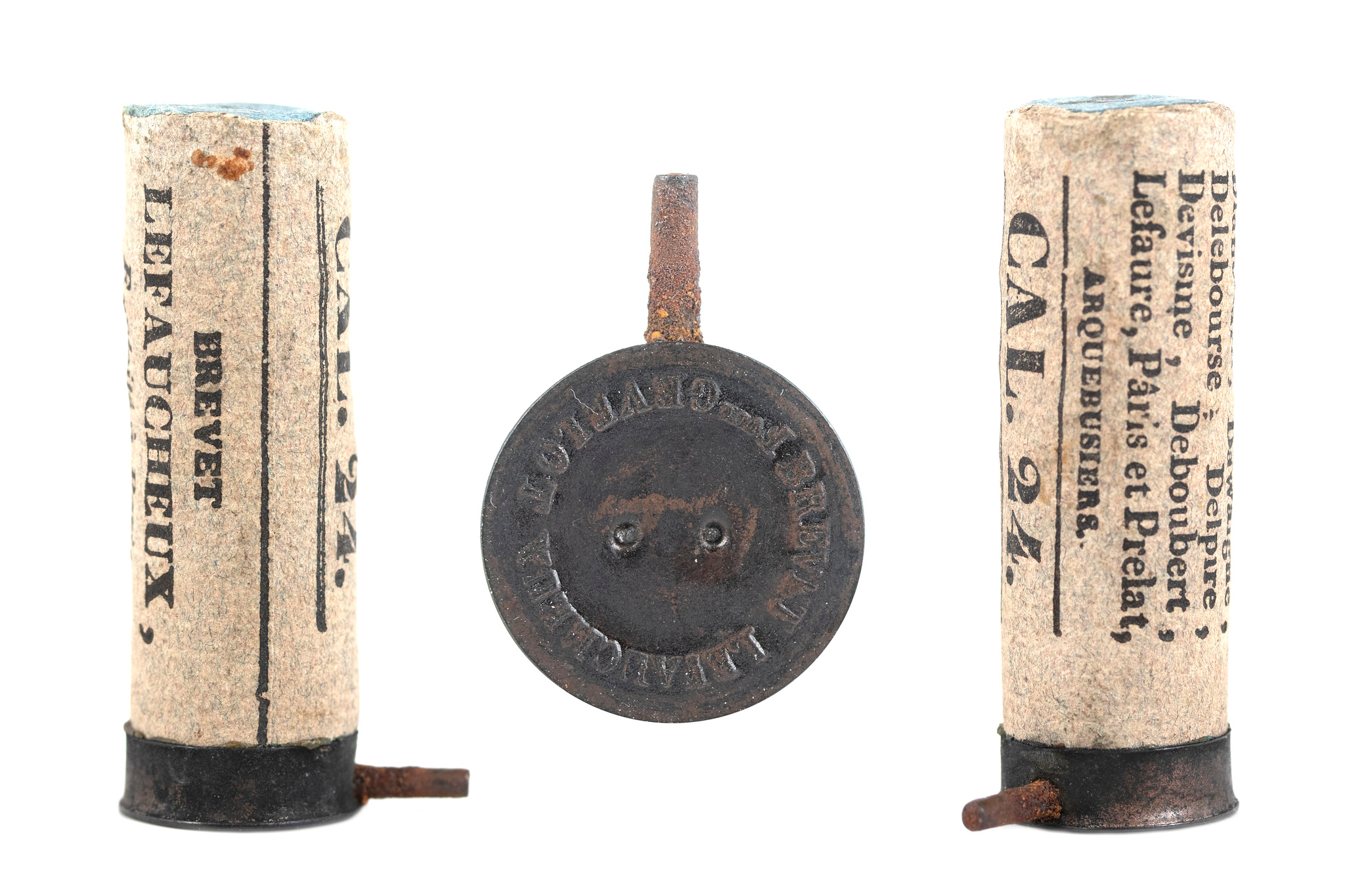
Lefaucheux’s design also pays close attention to the cartridge’s base, or “virole,” which is made of copper. This component is precisely engineered to ensure a snug fit within the firearm’s breech, further improving the system’s safety and reliability.
Firing Mechanism: Efficient and Reliable
Lefaucheux’s patent application provides a detailed description of the pinfire system’s firing process. When the trigger is pulled, the hammer strikes the protruding pin on the cartridge, driving it into the primer and igniting the gunpowder. This direct and specific ignition method ensures a reliable and efficient firing process, a notable improvement over the multi-step ignition mechanisms used in previous firearms.
To accommodate the unique design of the pinfire cartridge, Lefaucheux modified the firearm’s breech and hammer. The breech is specifically designed to efficiently load and secure the pinfire cartridges, while the hammer is engineered to strike the pin with precision. These design choices not only simplify the loading process but also significantly reduce the time between shots, offering a clear advantage in various shooting contexts.
Cartridge Innovations: Integrated Primer and Gas Seal
Lefaucheux’s documentation to the Ministère highlights several innovative features in the pinfire cartridge’s construction. One of the most notable advancements is the integration of the primer directly into the cartridge, eliminating the need for a separate percussion cap. This integration streamlines the loading process and enhances the overall efficiency of the pinfire system.
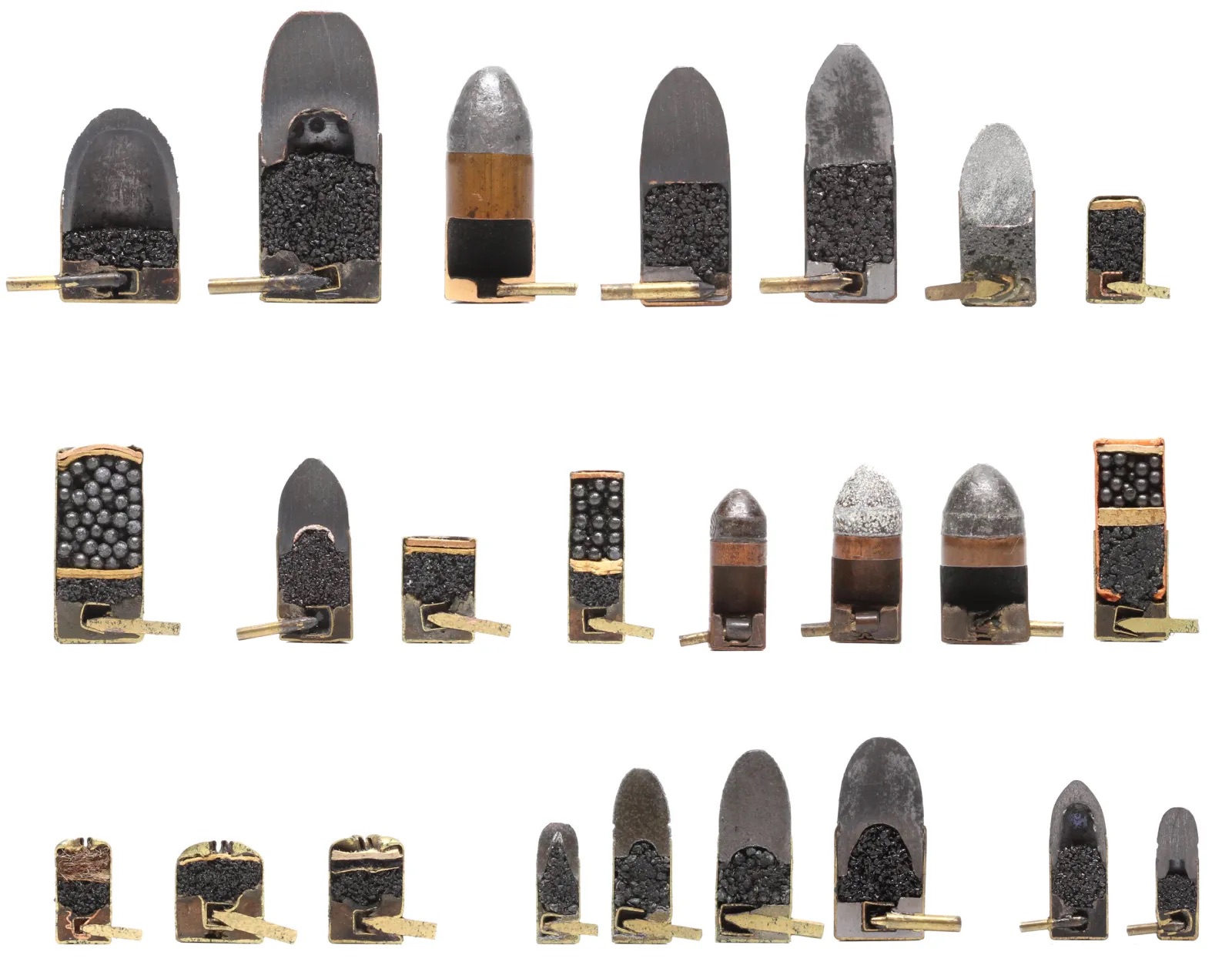
Another crucial aspect of the pinfire cartridge’s design is the copper base, or “virole,” which Lefaucheux frequently mentions in his communications. This component creates a tight seal within the breech, preventing the escape of gases upon firing. By ensuring a gas-tight seal, the pinfire system improves the firearm’s overall efficiency and contributes to its safety and reliability.
Lefaucheux’s patent submissions and correspondence with the French government showcase his deep investment in advancing firearms technology. His pinfire system, with its innovative cartridge design and refined firing mechanism, represented a significant leap forward in firearm design. The integration of the ignition mechanism into the cartridge itself, coupled with the meticulous engineering of the breech and hammer, underscores Lefaucheux’s commitment to improving the functionality, safety, and reliability of firearms.
The Global Reach and Evolution of the Pinfire System: From France to the World
The invention of the pinfire system by Casimir Lefaucheux in the mid-19th century marked a pivotal moment in the history of firearms technology. This revolutionary design, centered around the self-contained pinfire cartridge, not only streamlined the loading process but also significantly improved the safety, reliability, and efficiency of firearms. The transition from traditional muzzle-loading guns to breech-loading mechanisms, facilitated by the pinfire system, had far-reaching consequences that extended well beyond the borders of France.
Advantages and Innovations: Redefining Firearm Functionality
The pinfire system introduced a range of groundbreaking advantages that set it apart from earlier firearms. By integrating the bullet, gunpowder, and ignition mechanism into a single cartridge, Lefaucheux’s design dramatically reduced reloading times, benefiting both civilian and military users. Moreover, this integration minimized the risks associated with handling loose gunpowder and separate ignition mechanisms, such as misfires and accidental discharges.
The simplicity and directness of the pinfire mechanism, which relied on a hammer strike to ignite the cartridge directly, represented a significant improvement in firearm reliability and user safety. These innovative features redefined the functionality of firearms, setting new standards for the industry.
Impact on the Firearms Industry: Collaboration and Innovation
Lefaucheux’s decision to license his pinfire technology played a crucial role in its widespread adoption, particularly in France and Belgium. This collaborative approach fostered a period of intense innovation and diversity in pinfire firearms production. Jules Joseph Chaudun, a key figure in the early days of the pinfire system’s expansion, made significant improvements to the cartridge design, enhancing its reliability for use in Lefaucheux’s pistols. These advancements were instrumental in establishing the pinfire system’s reputation for reliability and efficacy.
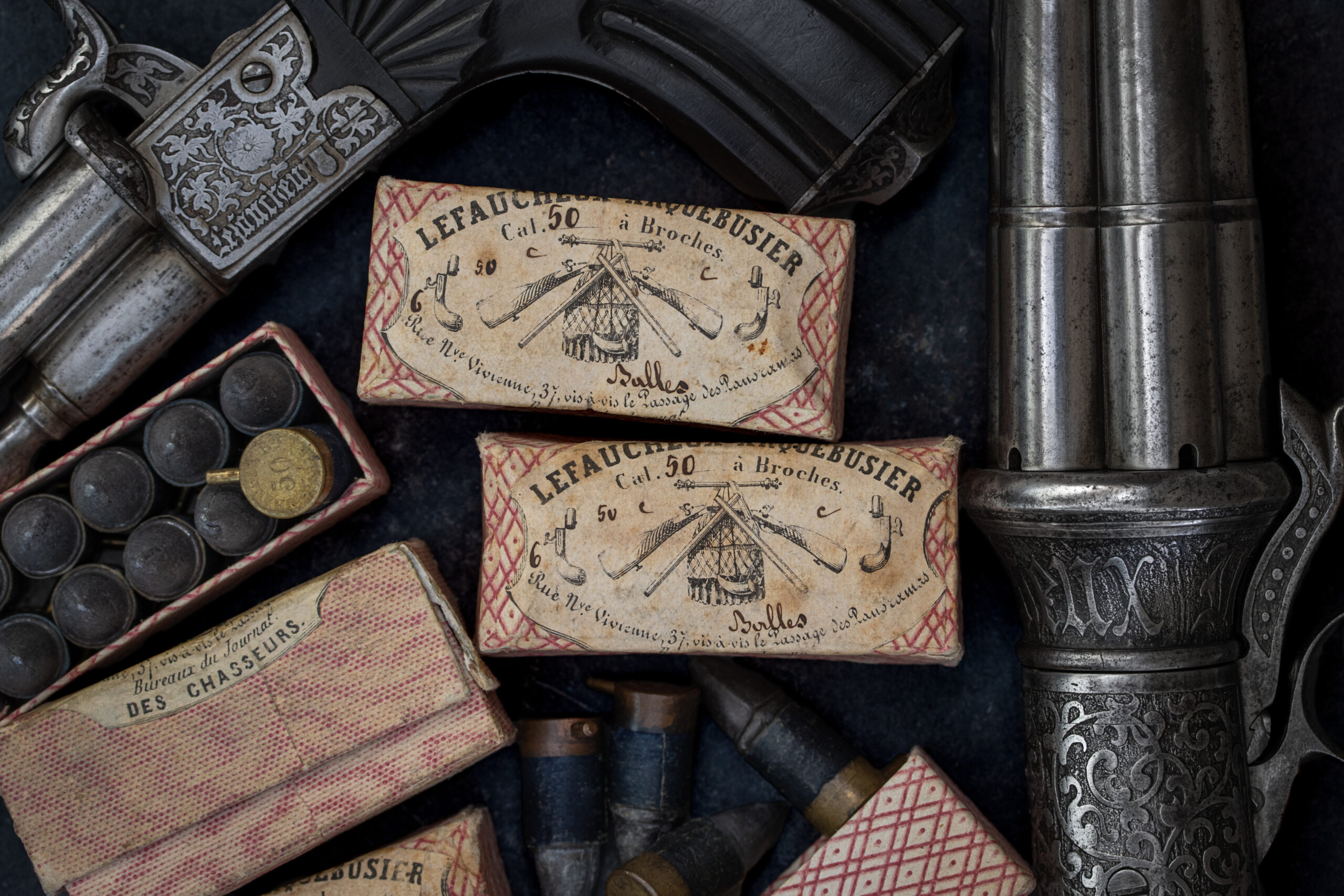
The legacy of the pinfire system continued to grow even after Casimir Lefaucheux’s death, with his son Eugène playing a vital role in its proliferation. The development of the Lefaucheux Model 1854, a pinfire revolver, marked a new milestone in the system’s history. The Model 1854’s adoption by military forces worldwide, from Norway to Italy and the United States, underscored the pinfire system’s versatility and reliability, showcasing its suitability for diverse operational demands and combat scenarios.
Worldwide Adoption and Manufacturing: A Global Phenomenon
The appeal of the pinfire system quickly transcended European borders, with ammunition manufacturers from Argentina to the United States embracing this revolutionary technology. Despite varying levels of popularity across different regions, the global adoption of the pinfire system underscored its revolutionary design and functional superiority in the broader context of firearms technology.

Even in the United States, where the pinfire system was less prevalent, manufacturers such as the Union Metallic Cartridge Company recognized the value of this technology and contributed to its production. The absence of patent restrictions in countries like Spain and Belgium further catalyzed the mass production of pinfire firearms, enhancing their accessibility and global distribution.
The widespread adoption and mass production of pinfire firearms illustrated the system’s profound impact on the firearms industry, driving further innovations and setting new benchmarks for firearm design and functionality.
Legacy and Decline: The Enduring Impact of the Pinfire System
The pinfire system, a groundbreaking innovation in the mid-19th century, left an indelible mark on the evolution of firearm technology. Casimir Lefaucheux’s creation represented a significant leap forward in the design and functionality of firearms, offering unprecedented reliability, safety, and ease of use. The introduction of the pinfire system catalyzed a shift in firearms manufacturing and design philosophies, influencing a wide array of subsequent developments in the industry.
Lasting Impact on Firearm Technology: Integration, Safety, and Efficiency
The legacy of the pinfire system is evident in its profound impact on the approach to firearm design and ammunition manufacture. By introducing the concept of a self-contained cartridge, Lefaucheux not only simplified the operation of firearms but also paved the way for future innovations in ammunition technology. The principles underlying the pinfire system—integration, safety, and efficiency—became guiding tenets for subsequent developments in firearm technology, particularly in the design of ammunition.
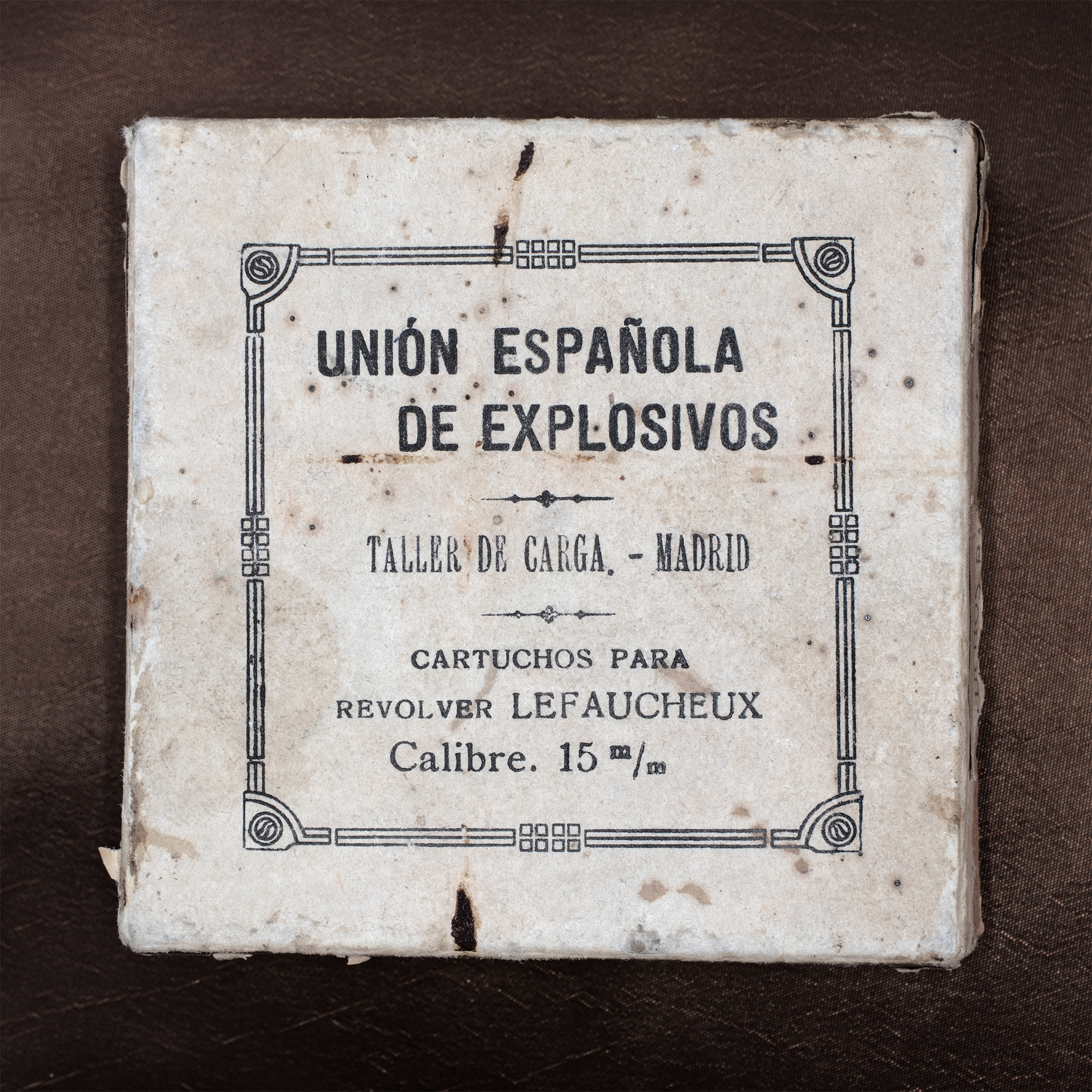
The adoption of the pinfire system by militaries and civilians across the globe underscored its significance. It demonstrated the viability and desirability of breech-loading mechanisms over the traditional muzzle-loading approach, setting a precedent that would steer the direction of future firearm innovations. The pinfire system’s success showcased the potential for more reliable, safer, and user-friendly firearms, inspiring gun makers and designers to pursue further advancements in these areas.
The Decline of the Pinfire System: The Rise of Centerfire Cartridges
Despite its groundbreaking design and widespread adoption, the pinfire system eventually faced a decline in the latter half of the 19th century. This decline was largely due to the emergence of centerfire cartridges, which offered several advantages over the pinfire system. One of the primary advantages of centerfire cartridges was their improved safety features. The exposed pin on the pinfire cartridge could be prone to damage or accidental discharge if not handled carefully. In contrast, centerfire cartridges had the primer located in the center of the cartridge base, which was better protected and less likely to be accidentally ignited.
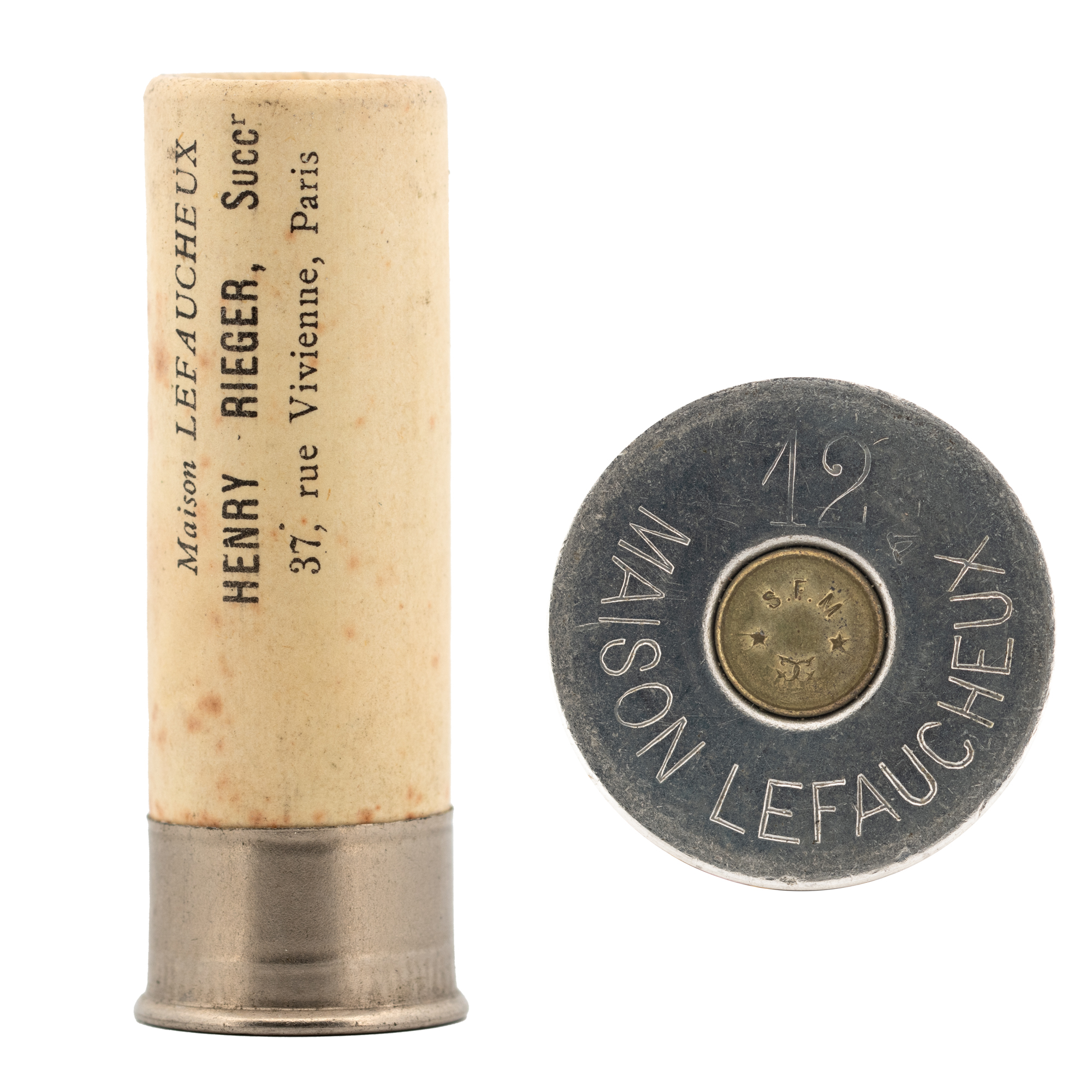
Centerfire cartridges also offered a more robust and reliable ignition method. The centerfire primer was less susceptible to moisture and other environmental factors that could affect the reliability of the pinfire system. This improved reliability was particularly important in military applications, where the dependability of firearms could be a matter of life and death.
Another factor contributing to the decline of the pinfire system was the increasing standardization of ammunition. Centerfire cartridges, with their more consistent design and dimensions, were better suited to meet the growing need for interchangeable ammunition between different weapons.
As centerfire cartridges gained popularity, gun manufacturers and ammunition producers began to focus their efforts on developing and refining centerfire designs. This shift led to a gradual decline in the production and use of pinfire firearms and ammunition, as armies and civilian shooters alike recognized the benefits of the newer technology.
Reflecting on the Lefaucheux Legacy: Innovation and Progress
Despite the eventual decline in its use, the importance of the pinfire system in the evolution of firearms cannot be overstated. Casimir Lefaucheux’s invention broke new ground in firearm technology, offering insights and innovations that would influence the development of firearms for decades to come. The introduction of the pinfire system marked a pivotal moment in the history of firearms, embodying the spirit of innovation and progress that characterizes the field.
Lefaucheux’s legacy extends beyond the pinfire system itself, as his work laid the foundation for future advancements in firearms technology. The principles he pioneered—integration, safety, and efficiency—continue to guide gun designers and manufacturers to this day. By demonstrating the potential for more reliable, safer, and user-friendly firearms, Lefaucheux set a new standard for the industry and inspired generations of innovators to push the boundaries of what was possible.
The story of the pinfire system and its creator, Casimir Lefaucheux, serves as a testament to the power of innovation and the relentless pursuit of progress. While the pinfire system may have eventually been superseded by newer technologies, its impact on the field of firearms cannot be understated. It remains a shining example of how one person’s vision and dedication can reshape an entire industry and leave a lasting legacy that endures long after their time.
In conclusion, the pinfire system’s legacy extends far beyond its historical significance as a technological milestone. It represents a spirit of innovation, a commitment to safety and reliability, and a desire to continually improve and refine the tools we use. As we reflect on the life and work of Casimir Lefaucheux, we are reminded of the enduring impact that one person’s ideas can have on the world, and the importance of preserving and celebrating the stories of those who have shaped our technological landscape.
Join and Support the Legacy of Innovation
Become a Part of Casimir Lefaucheux’s Enduring Legacy
The Lefaucheux Museum, as the guardian of Casimir Lefaucheux’s remarkable innovations and contributions to the world of firearms technology, extends a warm invitation to enthusiasts, historians, and the curious alike to explore and engage with the legacy of a true pioneer. Your participation and support are crucial in continuing the mission to celebrate and disseminate the history and impact of Lefaucheux’s work.
Support Through Donations:
The museum relies on the generosity of its supporters to preserve the rich collection of pinfire firearms, technical drawings, and historical documents. Your donations aid in the curation of exhibits, the advancement of educational programs, and the overall maintenance of the museum’s vast resources. Every contribution, large or small, plays a significant role in our ongoing efforts. To make a donation, please visit our Membership & Support page.
Engage with Us:
We believe that community engagement goes beyond financial contributions. We invite you to become a member of the museum for exclusive insights and benefits, volunteer your expertise, or help amplify our mission through word-of-mouth and social sharing. Your involvement is invaluable to our community and helps ensure the legacy of innovation continues to inspire.
Stay Connected:
Stay abreast of the latest news, upcoming events, and special exhibitions at The Lefaucheux Museum by following us on social media and subscribing to our newsletter. Join a vibrant community of individuals passionate about the intersections of history, technology, and the arts, all brought together by the pioneering spirit of Casimir Lefaucheux.
Visit and Explore:
The Lefaucheux Museum offers a unique gateway into the past, presenting meticulously curated exhibits that showcase the evolution of the pinfire system and its global impact. From rare pinfire firearms to educational resources and technical papers, the museum provides a comprehensive exploration of Lefaucheux’s contributions to firearm technology.
We are profoundly grateful for your interest and support. Together, we can ensure that the story of Casimir Lefaucheux, marked by relentless pursuit of innovation and improvement, continues to enlighten and captivate future generations. Join us in preserving the past and inspiring the future, as we celebrate the indelible legacy of a master of firearm innovation.


